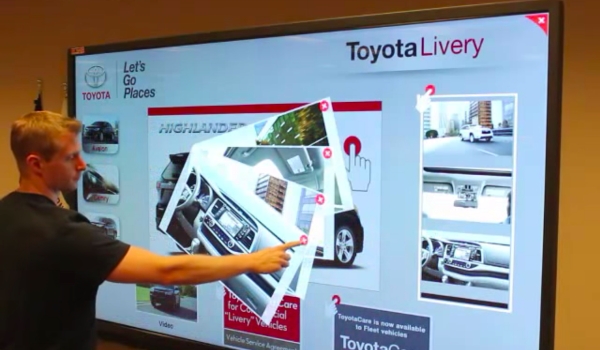
Jul 15 2022
8 min read


Jul
Studies have shown that customers prefer self-service technologies such as self-checkout rather than engaging with store associates, even for simple tasks like checking inventory and prices. When customers interact and make a purchase, they feel it’s their decision without any intervention.
This reliability is crucial! Customer interaction through self-service is universal across all sectors. A similar function can be achieved using interactive digital signage. How? Let’s begin by understanding what interactive digital signage entails.
If personalization is the future of business, interactive digital signage is the key to that future.
Yes, interactive digital signage puts the users at the forefront, making it one of the most productive marketing tools.
The traditional digital signage boards play promotional content, advertisements, and information that the general audience may simply view and pass on. But when you introduce interactivity, you revamp your marketing strategy.
How?
Interactive digital displays offer users a ‘personalized experience’ by putting them in the driving seat and allowing them to control what they see on the screens and how they see it.
As a result, it equips the brands with uniquely dynamic content that helps them stand out with more excitement & engagement on the platter for their audience.
You’ll surely agree that lack of personalization, mainly in the case of retail marketing through digital signage, has caused much toil-and-moil for marketers. But, with the interactive element rising to the surface, offline and online marketing channels are now flooded with super-engaging promotions and brand stories that unfailingly generate and sustain the interests of the audience.
Book My personalized demoIs interactive digital signage the best choice for offline marketing?
Yes. Not only for marketing, for strengthening brand visibility too!
Why?
It’s due to the significant advancement of interactive technology caused by the invention of motion sensors, the Internet of Things, gesture control, mid-air haptic interaction, transparent touch screens, interactive digital signage software, and whatnot.
Brands can thus go beyond the usual, experiment, and make a remarkable impression on their users.
Before getting into the ’types of interactivity’ users mostly fall for, let’s go through the following examples. These examples show how big brands leverage interactive technology for their digital signage systems and set new marketing trends.
Checkout how different brands all around the world have transformed their advertisements into a participatory activity and made it fun for the audience. The examples will give you a fairer idea of the extent to which you can stretch interactive digital signage and how it can induce the users to purchase.
At the Capitol mall of Singapore, consumers can interact with the vast array of products via a moving interactive digital screen. They can stop by one presentation, click on the items they are interested in, and get detailed information in just a few clicks. Here’s a sneak peek at the grand experience:
Nescafe broke all conventional norms of product marketing and has gone above the usual marketing benchmark to promote their cold brew coffee at the Shanghai metro station. The interactive digital screen lets the users play a fun game with the help of motion sensor technology and win a free bottle of the newly launched coffee variant. Take a look at how they did it:
The showroom welcomes visitors with a uniquely-designed interactive digital signage that helps them view the showroom map, find access points, and visit the photo and video gallery— all at a go via touchscreen interactivity. The brand has combined interactive digital wayfinding with information and entertainment to offer the visitors an unforgettable experience. Let’s see how they’ve achieved it.
KitKat drove consumers crazy with free chocolate bar offerings through an interactive out-of-home digital signage solution. The interactive digital display showed a dancing avatar that encouraged the nearby commuters to shake a leg with it. On winning the dance game, the participants were rewarded with a free chocolate bar. Imagine the kind of engagement these interactive digital signs can bring!
Don’t just imagine, take a look at the buzz it created in the video below:
Interactivity can be of many types depending on the projects and marketing needs, as you can see in the above examples. Here we have presented a list of the most popular interactive digital signage technologies that have been quite a buzz in the global market.

The most popular and accessible type of interactivity can happen through touchscreen digital displays.
Since the 1980s, touchscreen technology has undergone a revolutionary transformation in customer engagement, now regarded as a mature tool featuring faster response times and finer touch sensitivity.
Implementing interactive digital signage effectively requires specialized hardware to ensure a seamless user experience. High-quality touchscreen displays, including capacitive touchscreens, are crucial for providing precise, responsive, and multi-touch interactions. This makes them particularly well-suited for enhancing customer interactions in all environments.
With the backup of smart digital signage software and highly compatible signage players, you can overcome the hardware challenges easily and load your static displays with a package of entertainment, making it tremendously interactive.
A few common uses of touchscreen interactivity on digital signage are:
Self-service kiosks
Special advertisements
Discount and offer announcements
Here’s an example of interactive digital signage that employs touchscreen wayfinding technology and makes navigation through a vast land super easy. Take a look.
It’s been a long time since the world has witnessed the magic of touchscreen technology.With the increasing urge to invent more precise versions of interactivity, the smart signage technology has emerged beyond touch & tap. Technology connoisseurs are predicting that touchless isn’t going anywhere; it is here to stay and change the future of interactive digital signage. Let’s explore a few popular kinds.
The mid-air haptic interactivity offers more style but less precision.
When applied to digital signage with camera installations and ultrasonic sensors, the screens receive and respond to the finger movements of the user and deliver corresponding reactions and desired results. The difference is that you are not touching the screen here, only mimicking the touch gestures at a certain distance from the screen.
In the post-pandemic era, when people are highly concerned about hygiene, this is a great option for businesses to increase engagement without risking consumers’ health.
Common uses of mid-air haptic interactivity on digital signage are:
Digital menu board (for choosing and buying products)
Gaming
Virtual reality & Augmented Reality
Self-service kiosks
Here’s an example
The techno-geeks among the millennials and Gen-Zs are going crazy over the motion-gesture-controlled screen activities, mainly because it offers them the chance to experience mixed reality.
Video gesture control technology allows users to interact with multimedia content and enjoy an immersive experience, even in 3D interactivity.
The users need to move from one position to the other according to the instructions or activity levels mentioned on the screen in order to access, manipulate and engage with the available content.
Sometimes the technology requires only hand gestures to interact with the content successfully. Like the example below:
Some common uses of motion & gesture control in the interactive display are:
In-store interactive shopping
Games and infotainment
Retailtainment
Museum exhibits
Innovative promotions
Here’s another example:
QR codes have widespread use in interactive digital signage across the industries. The simplicity of adding a QR codes to any digital signage is what works behind the extensive adoption of this touchless technology.
You can easily share brand information, product lists and catalogs, restaurant menus, web pages, wayfinding maps, service details, and other valuable matters via a QR code on the interactive digital screen.
Users need only a QR code scanner app on their mobile devices to receive relevant information. Most of them have it now, thanks to online payment features! They can then go through the same on the move, or even later at home, and make proper purchase decisions.
QR code interaction happens mainly to share the following with the audience:
General brand information
Website pages & social media profiles
Marketing collaterals like brochures, manuals, etc.
Explore this interactive advertisement by Olympe to promote their musical instruments and find some new possibilities with QR code interactivity.
Augmented reality-driven interactivity allows brands to create a thrilling experience amalgamating the viewers’ artificial environment and real-world environment together. It’s better to see for yourself how it works to understand the excitement and amusement it offers to the audience. Watch the video below the list of common uses.
Common uses of AR-driven interactive digital signage systems:
Brand promotions
Unique product launch programs
Engaging advertisements
Special DOOH campaigns
I think you have already calculated the benefits, haven’t you? No? Are you still in awe and can’t decide if interactivity will really make any difference in your business turnovers? Well, read on to know the best benefits interactive digital signage can bring to your business, irrespective of the industry it belongs to.
But before that checkout the two incredible statistics on digital interactivity:
81% of consumers have agreed on the fact that interactive content grabs attention more effectively than static content on digital signage or elsewhere.
Interactive video advertisements get 47% more viewing time compared to non-interactive or static ones.
For more interesting statistics related to digital signage, visit this blog.
Do you feel the urge to deploy interactive signage now? Explore the benefits:
Interactive signage brings you the scope for dynamic advertising using smart, appealing, and entertaining content. It compels the audience to engage with your brand and remember the unique experience of that interaction for a long time.
Interactive digital signage is a powerful tool for gathering data and insights into customer behavior. Every interaction, whether it’s a touch on a screen, a scanned QR code, or a gesture in front of a motion sensor, generates valuable data. This data can then be analyzed to understand peak usage times, popular content, and customer preferences. For example, retail stores can track frequently viewed products to optimize inventory and promotions. Additionally, advanced analytics enable audience segmentation, allowing for targeted marketing and real-time adaptation to trends.
One-of-a-kind branding is what you ensure when you choose interactive technology. Your digital signage content, promotions, advertisements, and contests will be highly innovative, and out-of-the-box if your marketing team brainstorms and pulls off new ideas perfectly.
Interactive digital signage allows you to captivate your audience with original content, helping you surpass competitors and achieve success. In the retail sector, for example, touchscreens can recommend products based on past purchases, enhancing the shopping experience. Self-service kiosks streamline the process, enabling customers to explore features, compare prices, and read reviews with ease. Additionally, integrating augmented reality (AR) in stores provides virtual try-ons, boosting customer satisfaction and fostering brand loyalty.
Because of interactive signage, self-service at retail shops, shopping malls, hospitals, and many other places has become a cakewalk. Self-check-ins and check-outs have been a boon to the hospitality industry. Click-and-collect has also made shopping easy for 2022 buyers.
Have you ever asked today’s consumers what they prefer to experience while shopping or looking for a service? If you do, the answer would be ‘comfort, ease of shopping, and bearable waiting in the queues’.
So, if you want your customers to leave your premises happily today and come back smiling tomorrow, deploy interactive digital signage now!
Adding the interactive element to your digital signage screens will enhance audience engagement and the effectiveness of the campaigns. It will add more value and relevance to the content you display.
Employing interactive digital signage will be a game-changing shift for your business! Don’t be late to embrace it.
Take complete control of what you show on your digital signage & how you show it.
Take complete control of what you show on your digital signage & how you show it.
Start Free Trial Schedule My Demo
Jul 15 2022
8 min read

Apr 29 2021
6 min read

Dec 22 2022
5 min read

Oct 25 2022
8 min read